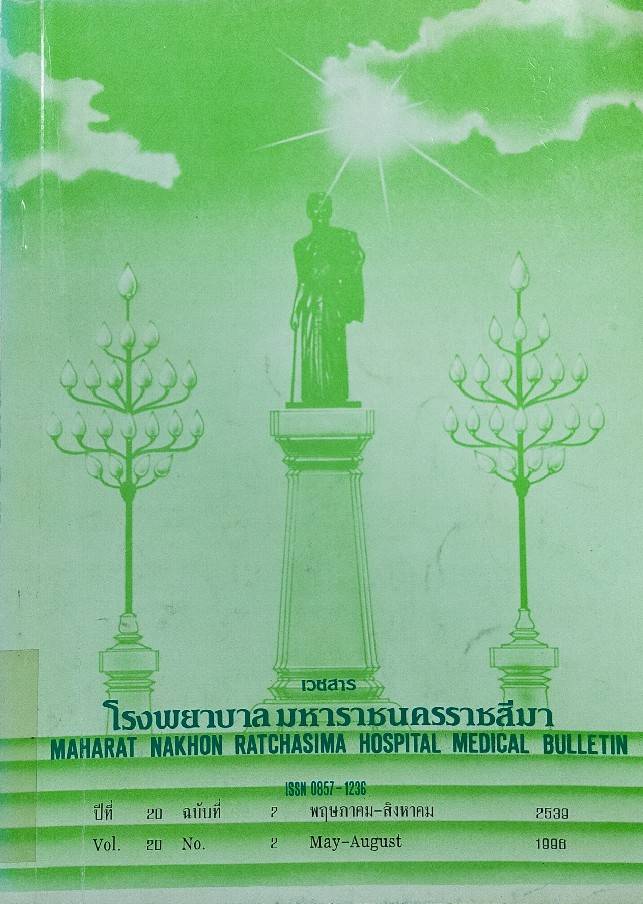นมแม่และอาหารเสริมของทารกในคลินิกเด็กดีโรงพยาบาลมหาราชนกรราชสีมา
Main Article Content
Abstract
This is a report of a hospital-based cross-sectional study based on interviewing of mothers with 0-5 months old children. The objectives are to determine the food characteristics in relation to the weight of O-5 months old children fed by breastfeeding alone, breastfeeding with formula, and formula alone. The result showed that mothers who have no need to work outside or rather low family income will give breastfeeding alone to their children more than mothers with rather high tamily income. Even through a large number of the latter give breastfeeding, a large number of them also give supplementary food to their children before appropriate time. Most of the supplementary food is made up of rice, banana, packaged finished supplementary food, fruit juice, honey or sweetened condensed milk, egg, meat and in particularly water. These supplementary food become obstacles to the exclusive breastfeeding behavior. Regarding the children weight, it was found that those with breastfeeding alone does not show a statistically difference in weight from those with formula alone and both formula and breastfeeding. The study has proved that children with breastfeeding have no lesser weight than those with formula.
Article Details

This work is licensed under a Creative Commons Attribution-NonCommercial-NoDerivatives 4.0 International License.
References
พรสิณี อมรวิเชษฐ์ และยุพา พูนขำ (2536) โครงการศึกษาสภาวะการเลี้ยงลูกด้วยนมแม่กองอนามัยครอบครัว 45:21
โยธี ทองเป็นใหญ่ และวรพันธ์ พิไชยแพทย์ (2537) การเลี้ยงลูกด้วยนมแม่ในจังหวัดนครราชสีมาเวชสารโรงพยาบาลมหาราชนครราชสีมา 18:223-234
Brown K.H. et al. (1988) Infant feeding practices and their relationship with diarrheal and other diseases in Huascar (Lima), Peru
Butte N.F. et al. (1984) Human milk intake and growth in exclusively breast-fed infants. J Pediatr 104:187-195
Derricle B. Jelliffe and E.F. Patricellife The Volume and Composition of human milk in poorly nourished communities. The Americare
Fishuat M. Murphy D, Neifert M et al. (1981) Bronchomamary axis in the immune response to respiratory syncytial virus. J Pediatr 99: 186-191, 1981.
Goldblum RM, Aulstedt S, Carlsson B et al. (1975) Antibody forming cells in human colostrum after oral immunization.Nature (London) 797-799.
Lucas, A. et al. Breast milk and subsequent intelligence quotient in children born preterm. Lancet. 1992; 339:261-264.
Rowland M.G.M. (1986) The weanling's dilemma: are we making progress? Acta Paediatr Scnd, Supp. 323:33-42
Seard, N.F. Walker, W.A. The Role of Breast Milk in the Development of the Gastrointestinal Tract. Nutrition Reviews.1988;465:1-8
UNICEF (2535) บันได 10 ขั้น สู่ความสำเร็จในการเลี้ยงลูกด้วยนมแม่
UNICEF (2538) เป้าหมายเพื่อเด็กของประเทศไทยปี 2538.
Victora C.G. et al. (1987) Evidence for protection by breastfeeding against infant deaths from infectious diseases in Brazil.Lancet 319-321.
Vis, H.L., Ruchababisha, M. R Hennart, P. (1987) Breastfeeding and the growth and development of the infant. Int. J. Gynecol. Obstet. 239-248.
World Health Assembly: Breastfeeding and Health for all. Lancet. 1981:1254.

